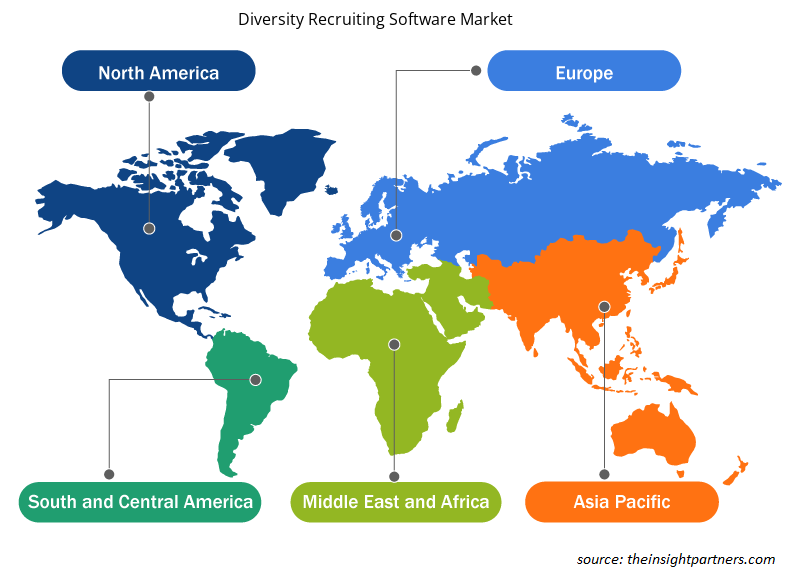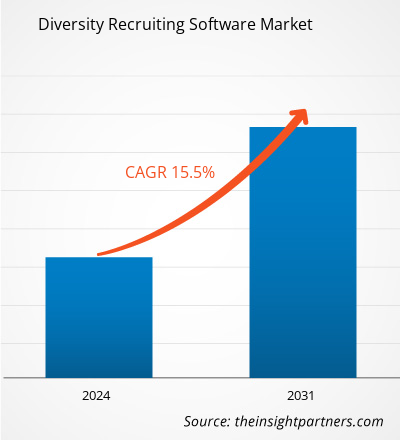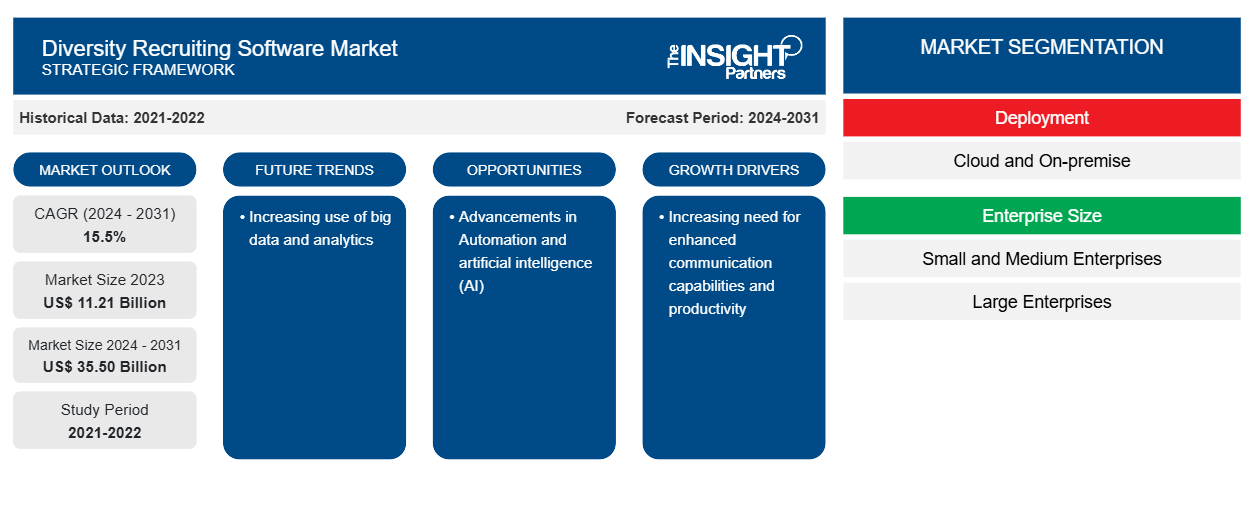Der globale Markt für Diversity-Recruiting-Software soll von 11,21 Milliarden US-Dollar im Jahr 2023 auf 35,50 Milliarden US-Dollar im Jahr 2031 wachsen; von 2024 bis 2031 wird eine durchschnittliche jährliche Wachstumsrate von 15,5 % erwartet. Die zunehmende Nutzung von Big Data und Analysen dürfte weiterhin ein wichtiger Trend auf dem Markt für Diversity-Recruiting-Software bleiben.
Marktanalyse für Diversity-Recruiting-Software
Die wachsende Nachfrage nach verbesserter Kommunikation und Produktivität ist der Haupttreiber der Diversity-Recruiting-Softwarebranche. Recruiting-Softwarelösungen, darunter auch Bewerbungsverfolgungssysteme, fördern die Kommunikation, indem sie sowohl Kandidaten als auch Personalvermittler auf dem Laufenden halten.
Marktübersicht für Diversity-Recruiting-Software
Diversity-Recruiting-Software ist eine hochmoderne technologische Lösung, die den Rekrutierungsprozess verbessert und rationalisiert und gleichzeitig Vielfalt und Inklusion in einem Unternehmen fördert. Dieses Programm verwendet komplexe Algorithmen und Datenanalysen, um einen breiten Pool kompetenter Personen für Stellenangebote zu finden und einzustellen. Einer der wichtigsten Vorteile von Diversity- Recruiting- Software ist ihre Fähigkeit, unbewusste Vorurteile während des gesamten Einstellungsprozesses zu beseitigen. Das Programm verwendet künstliche Intelligenz und maschinelles Lernen, um Stellenbeschreibungen zu scannen und potenzielle Vorurteile wie geschlechtsspezifische Sprache oder altersbezogene Präferenzen zu identifizieren. So wird sichergestellt, dass Stellenanzeigen inklusiv sind und ein vielfältiges Spektrum an Kandidaten ansprechen. Darüber hinaus ermöglicht das Programm Personalvermittlern, ein größeres Publikum zu erreichen, indem Stellenausschreibungen automatisch auf zahlreichen auf Vielfalt ausgerichteten Job-Websites veröffentlicht werden.
Passen Sie diesen Bericht Ihren Anforderungen an
Sie erhalten kostenlos individuelle Anpassungen an jedem Bericht, einschließlich Teilen dieses Berichts oder einer Analyse auf Länderebene, eines Excel-Datenpakets sowie tolle Angebote und Rabatte für Start-ups und Universitäten.
- Holen Sie sich die wichtigsten Markttrends aus diesem Bericht.Dieses KOSTENLOSE Beispiel umfasst eine Datenanalyse von Markttrends bis hin zu Schätzungen und Prognosen.
Treiber und Chancen des Diversity-Recruiting-Softwaremarkts
Steigender Bedarf an verbesserten Kommunikationsfähigkeiten und Produktivität zur Begünstigung des Marktes
Einer der Hauptaspekte, der die Branche der Diversity-Recruiting-Software vorantreibt, ist die wachsende Nachfrage nach verbesserter Kommunikation und Produktivität. Recruiting-Softwarelösungen wie Bewerbungsverfolgungssysteme tragen dazu bei, die Kommunikationskanäle zwischen Kandidaten und Personalvermittlern zu verbessern und sie während des gesamten Rekrutierungsprozesses auf dem Laufenden zu halten. Für erfolgreiches Diversity-Recruiting ist eine effektive Kommunikation erforderlich. Sie ermöglicht Personalvermittlern den Zugriff auf einen größeren Kandidatenpool und stellt sicher, dass alle Bewerber, unabhängig von ihrem Hintergrund, die gleichen Chancen haben, für eine Stelle in Betracht gezogen zu werden. Durch den Einsatz von Technologien wie Messaging-Apps, Chatbots und sozialen Medien können Personalvermittler Top-Talente effektiver entdecken, mögliche Kontakte identifizieren und mit Kandidaten und Mitarbeitern kommunizieren.
Fortschritte in der Automatisierung und künstlichen Intelligenz (KI)
Unternehmen nutzen zunehmend automatisierte Lebenslauf-Screening-Systeme, die auf künstlicher Intelligenz (KI) basieren, um die Fähigkeiten und Fachkenntnisse der Kandidaten zu bewerten. Dieser Trend dürfte den Diversity-Recruiting-Prozess beschleunigen und vereinfachen. KI-basierte Technologien wie Resume Scorer und optische Zeichenerkennung (OCR) werden verwendet, um die Lebensläufe der Kandidaten den für einen bestimmten Job erforderlichen Fähigkeiten und Kompetenzen zuzuordnen. Diese Technologien können fachliche Fähigkeiten, berufsbezogene Soft Skills und sogar Persönlichkeitsmerkmale des Bewerbers erkennen. KI eliminiert Fehler, die mit der manuellen Überprüfung Tausender von Lebensläufen verbunden sind, indem sie das Screening-Verfahren automatisiert.
Segmentierungsanalyse des Marktberichts zur Diversity-Recruiting-Software
Wichtige Segmente, die zur Ableitung der Marktanalyse für Diversity-Recruiting-Software beigetragen haben: Einsatz und Unternehmensgröße.
- Basierend auf der Bereitstellung ist der Markt in On-Premises und Cloud unterteilt. Das Cloud-Segment hatte im Jahr 2023 einen größeren Marktanteil.
- Basierend auf der Unternehmensgröße ist der Markt in kleine und mittlere Unternehmen ( KMU ) und Großunternehmen unterteilt. Das Segment der Großunternehmen hatte im Jahr 2023 einen größeren Marktanteil.
Marktanteilsanalyse für Diversity-Recruiting-Software nach geografischen Gesichtspunkten
Der geografische Umfang des Marktberichts zur Diversity-Recruiting-Software ist hauptsächlich in fünf Regionen unterteilt: Nordamerika, Asien-Pazifik, Europa, Naher Osten und Afrika sowie Südamerika/Süd- und Mittelamerika. Nordamerika dominierte den Markt für Diversity-Recruiting- Software im Jahr 2023. Der wachsende Bedarf an Softwarelösungen, die die Rekrutierung und Bindung einer vielfältigen Belegschaft unterstützen, wird durch die Anerkennung der entscheidenden Rolle der Vielfalt am Arbeitsplatz vorangetrieben. Unternehmen investieren in Softwarelösungen, um ihre Ziele in Bezug auf Vielfalt und Inklusion zu erreichen. In Nordamerika wird dieser Trend durch die steigende Zahl von Unternehmen, die Initiativen für Vielfalt und Inklusion verfolgen, noch verstärkt. Diese Unternehmen suchen nach Softwarelösungen, um vielfältige Talente effektiv zu identifizieren und anzuziehen sowie den Erfolg ihrer Diversity-Programme zu überwachen und zu bewerten.fuelled by the rising number of companies embracing diversity and inclusion initiatives. These organizations are seeking software solutions to effectively identify and attract diverse talent, as well as monitor and evaluate the success of their diversity programs.
Regionale Einblicke in den Markt für Diversity-Recruiting-Software
Die regionalen Trends und Faktoren, die den Markt für Diversity-Recruiting-Software während des Prognosezeitraums beeinflussen, wurden von den Analysten von Insight Partners ausführlich erläutert. In diesem Abschnitt werden auch die Marktsegmente und die Geografie von Diversity-Recruiting-Software in Nordamerika, Europa, im asiatisch-pazifischen Raum, im Nahen Osten und Afrika sowie in Süd- und Mittelamerika erörtert.

- Erhalten Sie regionale Daten zum Diversity-Recruiting-Softwaremarkt
Umfang des Marktberichts zur Diversity-Recruiting-Software
| Berichtsattribut | Details |
|---|---|
| Marktgröße im Jahr 2023 | 11,21 Milliarden US-Dollar |
| Marktgröße bis 2031 | 35,50 Milliarden US-Dollar |
| Globale CAGR (2024 - 2031) | 15,5 % |
| Historische Daten | 2021-2022 |
| Prognosezeitraum | 2024–2031 |
| Abgedeckte Segmente | Nach Bereitstellung
|
| Abgedeckte Regionen und Länder | Nordamerika
|
| Marktführer und wichtige Unternehmensprofile |
|
Marktteilnehmerdichte: Der Einfluss auf die Geschäftsdynamik
Der Markt für Diversity-Recruiting-Software wächst rasant, angetrieben durch die steigende Nachfrage der Endnutzer aufgrund von Faktoren wie sich entwickelnden Verbraucherpräferenzen, technologischen Fortschritten und einem größeren Bewusstsein für die Vorteile des Produkts. Mit steigender Nachfrage erweitern Unternehmen ihr Angebot, entwickeln Innovationen, um die Bedürfnisse der Verbraucher zu erfüllen, und nutzen neue Trends, was das Marktwachstum weiter ankurbelt.
Die Marktteilnehmerdichte bezieht sich auf die Verteilung der Firmen oder Unternehmen, die in einem bestimmten Markt oder einer bestimmten Branche tätig sind. Sie gibt an, wie viele Wettbewerber (Marktteilnehmer) in einem bestimmten Marktraum im Verhältnis zu seiner Größe oder seinem gesamten Marktwert präsent sind.
Die wichtigsten Unternehmen auf dem Markt für Diversity-Recruiting-Software sind:
- Diversity-Recruiting-Software
- Entelo, Inc.
- GR8 People, Inc.
- Greenhouse Software, Inc.
- EZ mieten
- SmartRecruiters
Haftungsausschluss : Die oben aufgeführten Unternehmen sind nicht in einer bestimmten Reihenfolge aufgeführt.

- Überblick über die wichtigsten Akteure auf dem Markt für Diversity-Recruiting-Software
Neuigkeiten und aktuelle Entwicklungen zum Markt für Diversity-Recruiting-Software
Der Markt für Diversity-Recruiting-Software wird durch die Erhebung qualitativer und quantitativer Daten nach Primär- und Sekundärforschung bewertet, die wichtige Unternehmenspublikationen, Verbandsdaten und Datenbanken umfasst. Im Folgenden finden Sie eine Liste der Entwicklungen auf dem Markt:
- Im Januar 2021 führte SmartRecruiters eine wichtige Initiative namens „Diversity Hiring Toolkit“ ein. Dieses Toolkit umfasst ein Reifegradmodell und Erfolgssäulen, die jeweils aus drei Schlüsselstandards bestehen. SmartRecruiters hat diese Standards sorgfältig ausgearbeitet, um einen erstklassigen Rahmen für Diversity-Rekrutierungsbemühungen zu schaffen. Im Rahmen dieses Toolkits ermutigt SmartRecruiters Unternehmen, am Diversity Hiring Assessment teilzunehmen. Dieses Assessment bietet eine umfassende und unvoreingenommene Bewertung des allgemeinen Diversity Hiring-Reifegrads eines Unternehmens. Es eignet sich für Unternehmen aller Größen und Branchen und wird Personen empfohlen, die ein tiefes Verständnis für die Talentakquise, das Marketing sowie die Diversity & Inclusion (D&I)-Initiativen ihres Unternehmens haben.
(Quelle: SmartRecruiters, Pressemitteilung, 2021)
Marktbericht zu Diversity-Recruiting-Software – Umfang und Ergebnisse
Der Bericht „Marktgröße und Prognose für Diversity-Recruiting-Software (2021–2031)“ bietet eine detaillierte Analyse des Marktes, die die folgenden Bereiche abdeckt:
- Marktgröße und Prognose auf globaler, regionaler und Länderebene für alle wichtigen Marktsegmente, die im Rahmen des Projekts abgedeckt sind
- Marktdynamik wie Treiber, Beschränkungen und wichtige Chancen
- Wichtige Zukunftstrends
- Detaillierte PEST/Porters Five Forces- und SWOT-Analyse
- Globale und regionale Marktanalyse mit wichtigen Markttrends, wichtigen Akteuren, Vorschriften und aktuellen Marktentwicklungen
- Branchenlandschaft und Wettbewerbsanalyse, einschließlich Marktkonzentration, Heatmap-Analyse, prominenten Akteuren und aktuellen Entwicklungen
- Detaillierte Firmenprofile
- Historische Analyse (2 Jahre), Basisjahr, Prognose (7 Jahre) mit CAGR
- PEST- und SWOT-Analyse
- Marktgröße Wert/Volumen – Global, Regional, Land
- Branchen- und Wettbewerbslandschaft
- Excel-Datensatz
Aktuelle Berichte
Verwandte Berichte
Erfahrungsberichte
Grund zum Kauf
- Fundierte Entscheidungsfindung
- Marktdynamik verstehen
- Wettbewerbsanalyse
- Kundeneinblicke
- Marktprognosen
- Risikominimierung
- Strategische Planung
- Investitionsbegründung
- Identifizierung neuer Märkte
- Verbesserung von Marketingstrategien
- Steigerung der Betriebseffizienz
- Anpassung an regulatorische Trends























 Kostenlose Probe anfordern für - Markt für Diversity-Recruiting-Software
Kostenlose Probe anfordern für - Markt für Diversity-Recruiting-Software